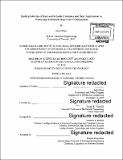| dc.contributor.advisor | Kripa K. Varanasi. | en_US |
| dc.contributor.author | Khan, Sami,Ph. D.Massachusetts Institute of Technology. | en_US |
| dc.contributor.other | Technology and Policy Program. | en_US |
| dc.date.accessioned | 2016-08-26T14:39:49Z | |
| dc.date.available | 2016-08-26T14:39:49Z | |
| dc.date.copyright | 2016 | en_US |
| dc.date.issued | 2016 | en_US |
| dc.identifier.uri | http://hdl.handle.net/1721.1/104029 | |
| dc.description | Thesis: S.M. in Technology and Policy, Massachusetts Institute of Technology, Institute for Data, Systems, and Society, Technology and Policy Program, 2016. | en_US |
| dc.description | Thesis: S.M., Massachusetts Institute of Technology, Department of Mechanical Engineering, 2016. | en_US |
| dc.description | Cataloged from PDF version of thesis. | en_US |
| dc.description | Includes bibliographical references (pages 93-106). | en_US |
| dc.description.abstract | Hydrophobic surfaces that are robust can have widespread applications in various industries including energy, hydropower, and transportation. In particular, hydrophobic materials promote dropwise condensation, which results in heat transfer coefficients that can be an order of magnitude higher than those seen in conventional filmwise condensation. Existing durable materials such as metals and ceramics are generally hydrophilic and require polymeric modifiers to render them hydrophobic, but these modifiers deteriorate in harsh environments. Therefore, robust hydrophobic surfaces have been difficult to realize and their widespread applicability has been limited. In this thesis, the class of ceramics comprising the lanthanide series rare-earth oxides (REOs) is studied for their hydrophobic potential. The unique electronic structure of the rare-earth metal atom inhibits hydrogen bonding with interfacial water molecules resulting in a hydrophobic hydration structure where the surface oxygen atoms are the only hydrogen bonding sites. Despite being inherently hydrophobic, the presence of excess surface oxygen on REOs can lead to increased hydrogen bonding and thereby reduce their hydrophobicity. Using X-ray Photoelectron Spectroscopy (XPS) and wetting measurements, surface stoichiometry and surface relaxations have been shown to impact wetting properties of REOs. Specifically, freshly sputtered ceria is shown to be hydrophilic due to excess surface oxygen (shown to have an O/Ce ratio of ~3), which when relaxed in a clean, ultra-high vacuum environment isolated from airborne contaminants reaches close to stoichiometric O/Ce ratio (~2.2) and becomes hydrophobic. Further, airborne hydrocarbon contaminants do not exclusively impact the wetting properties of REOs, and relaxed REOs are intrinsically hydrophobic. This thesis also demonstrates that thin-film coatings (~300 nm) of relaxed hydrophobic REOs show sustained dropwise condensation behavior for over 100 hours at accelerated saturated steam conditions without compromising structural integrity or hydrophobicity, and produce a tenfold enhancement in the heat transfer co-efficient (103 ± 5 kW/m 2K) compared to conventional filmwise condensation (usually <10 kW/m2K). Finally, the political economy of rare-earths has been studied to understand the causes for market failure. A knowledge assessment exercise finds that rare-earth prices greatly depend on the rise of competing technologies and alternative resources, and international trade policies. It is envisioned that robust hydrophobic rare-earth oxide ceramics will have far reaching technological applications, especially in dropwise condensation. | en_US |
| dc.description.statementofresponsibility | by Sami Khan. | en_US |
| dc.format.extent | 106 pages | en_US |
| dc.language.iso | eng | en_US |
| dc.publisher | Massachusetts Institute of Technology | en_US |
| dc.rights | M.I.T. theses are protected by copyright. They may be viewed from this source for any purpose, but reproduction or distribution in any format is prohibited without written permission. See provided URL for inquiries about permission. | en_US |
| dc.rights.uri | http://dspace.mit.edu/handle/1721.1/7582 | en_US |
| dc.subject | Institute for Data, Systems, and Society. | en_US |
| dc.subject | Mechanical Engineering. | en_US |
| dc.subject | Engineering Systems Division. | en_US |
| dc.subject | Technology and Policy Program. | en_US |
| dc.title | Hydrophobicity of rare-earth oxide ceramics and their application in promoting sustained drop-wise condensation | en_US |
| dc.type | Thesis | en_US |
| dc.description.degree | S.M. in Technology and Policy | en_US |
| dc.description.degree | S.M. | en_US |
| dc.contributor.department | Massachusetts Institute of Technology. Institute for Data, Systems, and Society | en_US |
| dc.contributor.department | Massachusetts Institute of Technology. Department of Mechanical Engineering | en_US |
| dc.contributor.department | Massachusetts Institute of Technology. Engineering Systems Division | en_US |
| dc.contributor.department | Technology and Policy Program | en_US |
| dc.identifier.oclc | 957289367 | en_US |
